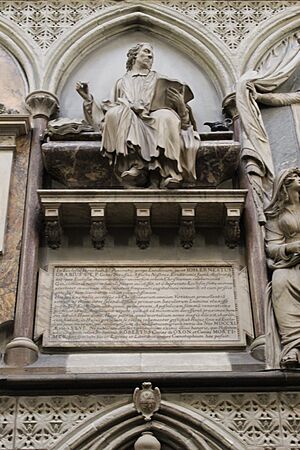John Ernest Grabe facts for kids


John Ernest Grabe (born July 10, 1666 – died November 3, 1711) was an important religious scholar from England. He was born in Königsberg, a city where his father, Martin Sylvester Grabe, taught about religion and history. Grabe became known for his deep studies of early Christian writings.
Contents
The Life of John Ernest Grabe
Early Religious Journey
When John Ernest Grabe was studying religion, he started to believe that the Protestant Reformation had caused a split in the Christian church. He felt that the Protestant churches were similar to some older groups that had separated from the main church long ago. He even thought about joining the Roman Catholic Church.
However, some Lutheran religious leaders talked with him. They showed him that the Church of England seemed to have a strong connection to the early Christian church. This connection, called "apostolic succession," and its respect for old traditions, was what Grabe was looking for.
Moving to England and His Work
Because of this, Grabe decided to move to England. He settled in Oxford and spent a lot of time studying at the famous Bodleian Library. In the year 1700, he became a priest. He also worked as a chaplain at Christ Church, Oxford, which is a college at Oxford University.
Grabe spent the rest of his life doing important scholarly work. He earned a special degree from Oxford, called a Doctor of Divinity (DD). He also received money from the king to support his studies.
Later Years and Legacy
John Ernest Grabe passed away on November 3, 1711. He was buried in St Pancras Old Church in London. His name is remembered on the Burdett Coutts Memorial as one of the important people whose graves were lost.
Years later, in 1726, a special monument was built for him in Westminster Abbey. This monument was created by the artist Francis Bird and paid for by Edward Harley, 2nd Earl of Oxford and Mortimer.
Some information about Grabe's life can be found in books written by other scholars. For example, Robert Nelson wrote about him in his book about George Bull.
John Ernest Grabe's Important Works
Grabe's writings show that he was very learned and worked hard. However, he sometimes struggled with critical thinking.
Collections of Ancient Writings
One of his main works was called Spicilegium SS. Patrum et haereticorum (1698-1699). This book was meant to collect writings from the first three centuries of the Christian church. However, he only finished the part covering up to the end of the second century. A second edition of this work was published in 1714.
Edited Editions of Other Works
He also prepared and published new editions of several important old texts, including:
- Justin Martyr's Apologia prima (1700), which was a defense of Christianity.
- Irenaeus's Adversus omnes haereses (1702), a book against false teachings.
- Bishop Bull's Latin works (1703).
- The first volume of the Septuagint (1707).
His edition of the Septuagint was very important. The Septuagint is an ancient Greek translation of the Hebrew Bible. Grabe based his edition on a very old manuscript called the Codex Alexandrinus. His work came out in four volumes between 1707 and 1720. It was finished by other scholars, Francis Lee and George Wigan, after Grabe's death.

